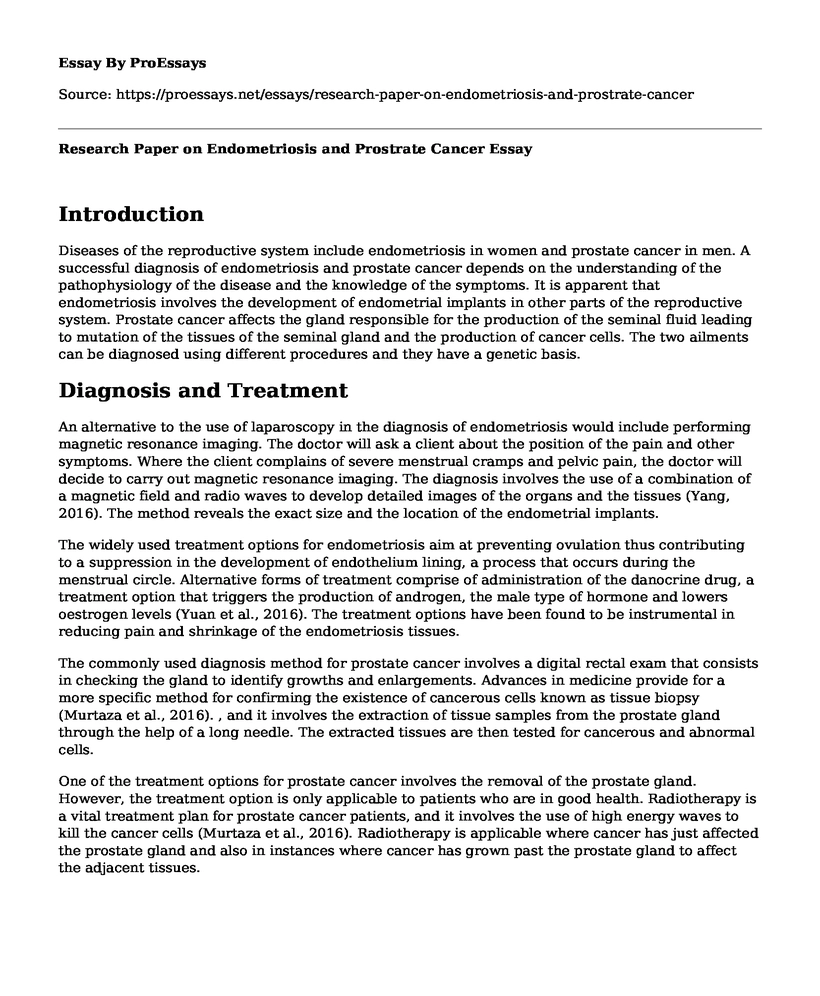Introduction
Diseases of the reproductive system include endometriosis in women and prostate cancer in men. A successful diagnosis of endometriosis and prostate cancer depends on the understanding of the pathophysiology of the disease and the knowledge of the symptoms. It is apparent that endometriosis involves the development of endometrial implants in other parts of the reproductive system. Prostate cancer affects the gland responsible for the production of the seminal fluid leading to mutation of the tissues of the seminal gland and the production of cancer cells. The two ailments can be diagnosed using different procedures and they have a genetic basis.
Diagnosis and Treatment
An alternative to the use of laparoscopy in the diagnosis of endometriosis would include performing magnetic resonance imaging. The doctor will ask a client about the position of the pain and other symptoms. Where the client complains of severe menstrual cramps and pelvic pain, the doctor will decide to carry out magnetic resonance imaging. The diagnosis involves the use of a combination of a magnetic field and radio waves to develop detailed images of the organs and the tissues (Yang, 2016). The method reveals the exact size and the location of the endometrial implants.
The widely used treatment options for endometriosis aim at preventing ovulation thus contributing to a suppression in the development of endothelium lining, a process that occurs during the menstrual circle. Alternative forms of treatment comprise of administration of the danocrine drug, a treatment option that triggers the production of androgen, the male type of hormone and lowers oestrogen levels (Yuan et al., 2016). The treatment options have been found to be instrumental in reducing pain and shrinkage of the endometriosis tissues.
The commonly used diagnosis method for prostate cancer involves a digital rectal exam that consists in checking the gland to identify growths and enlargements. Advances in medicine provide for a more specific method for confirming the existence of cancerous cells known as tissue biopsy (Murtaza et al., 2016). , and it involves the extraction of tissue samples from the prostate gland through the help of a long needle. The extracted tissues are then tested for cancerous and abnormal cells.
One of the treatment options for prostate cancer involves the removal of the prostate gland. However, the treatment option is only applicable to patients who are in good health. Radiotherapy is a vital treatment plan for prostate cancer patients, and it involves the use of high energy waves to kill the cancer cells (Murtaza et al., 2016). Radiotherapy is applicable where cancer has just affected the prostate gland and also in instances where cancer has grown past the prostate gland to affect the adjacent tissues.
Genetic Linkage
The pathophysiology of endometriosis including the role of oestrogen in the stimulation of endometrium implants makes the disease to have a genetic basis. Familial studies have been instrumental in understanding the disease as a genetic disorder resulting from multifactorial or polygenic inheritance. The presence of gene variants responsible for oestrogen biosynthesis is a significant risk factor (Yuan et al, 2016). Other familial and penetrant genes that add an incremental risk to the development of endometriosis include the gene responsible if the encoding of galactose- 1-phosphate uridyl transferase.
Prostate cancer results from the changes in deoxyribonucleic acid (DNA) found in a prostate cell. Parents are the source of an individual DNA, and the component determines how cells divide grow or die (Murtaza et al., 2016). Genetically mutated and inherited genes that have a connection with prostate cancer include the DNA mismatch and repair genes that are vital for repairing mistakes in normal individuals. Men with such mutated genes suffer from Lynch syndrome which increases the risk for the development of prostate and other tumors.
References
Murtaza, M., Salih, A. F., Illzam, E. M., &Sharifa, A. M. (2016). Prostate Cancer: Pathophysiology, Diagnosis, and Prognosis. IOSR Journal of Dental and Medical Sciences, 15, 122-126.
Yang, W., Guo, W., Le, W., Lv, G., Zhang, F., Shi, L., ... & Zhang, B. (2016). Albumin-bioinspired Gd: CuSnanotheranostic agent for in vivo photoacoustic/magnetic resonance imaging-guided tumor-targeted photothermal therapy. ACS nano, 10(11), 10245-10257.
Yun, B. H., Chon, S. J., Choi, Y. S., Cho, S., Lee, B. S., &Seo, S. K. (2016). Pathophysiology of endometriosis: the role of high mobility group box-1 and toll-like receptor 4 developing inflammation in the endometrium. PloS one, 11(2), e0148165.
Cite this page
Research Paper on Endometriosis and Prostrate Cancer. (2022, Jul 25). Retrieved from https://proessays.net/essays/research-paper-on-endometriosis-and-prostrate-cancer
If you are the original author of this essay and no longer wish to have it published on the ProEssays website, please click below to request its removal:
- Defending Vaccination in Children Essay Example
- Merchants of Doubt Documentary Essay Example
- Series of Events that Occurred During SARS II Paper Example
- Essay Sample on Medical-Surgical Nursing Evolution
- Essay on Alcoholics & Liver Transplants: Analyzing Factors & Treatments
- Health Care System Needs Improvement for Patient Safety - Essay Sample
- Free Essay on Navigating the Opioid Crisis: Impacts, Responses, and Future Directions in America







